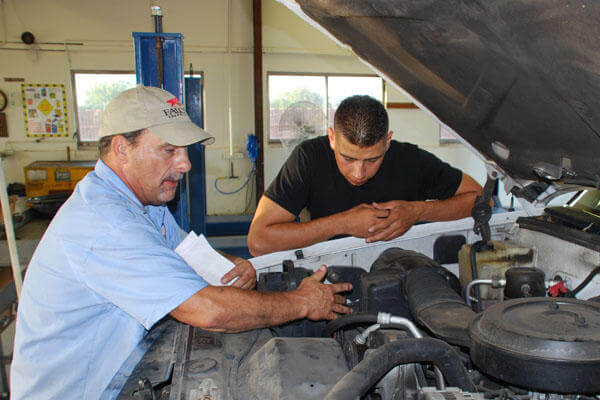If your vehicle's owner's manual has instructions for draining the liquid from the cooling system, follow them.
Eco-Logic: If you don't have a manual, or if it lacks such instructions, follow these steps to flush your cooling system and change the coolant without endangering the environment:
- Park the vehicle in a safe place, away from children and small animals.
Caution: Make sure that the engine is cold, the ignition is off, and the parking brake is on. - Place a bucket that can hold at least two gallons under the drain valve at the bottom of the radiator.
- Open the drain valve and allow the liquid to drain into the bucket.
Caution: Don't allow the liquid to drain onto the ground or into a storm drain or sewer. - Close the drain valve!
- Pour the used liquid into containers with tight-fitting lids. Label them clearly as "antifreeze" or "coolant," and place them away from kids and pets until you can dispose of them safely.
Tip: A funnel and some old gallon water jugs do the job as long as you pour carefully to avoid spilling the liquid on the ground and label them prominently, as in Step 8. - Open the radiator pressure cap and fill the radiator with water.
- Run the engine with the heater control on High for about ten minutes.
Caution: Keep an eye on the temperature gauge to make sure that the engine doesn't overheat. If your vehicle has an engine temperature warning light instead of a gauge, shut off the engine as soon as it lights up. - Shut off the engine and allow it to cool down until the water in the radiator is cool enough to touch. Then drain the water out of the system into the bucket again, and transfer it from there into more closed containers for disposal.
Label the containers "toxic water" to differentiate them from the others and to prevent someone from drinking their contents accidentally. - Close the drain plug and refill the system with water and coolant.
If you don't have pre-diluted coolant, mix sufficient equal parts of water and coolant to fill your system. The liquid should reach the "MAX" line on the coolant recovery reservoir or cover the fins in the radiator. If it doesn't, continue to add equal parts water and coolant until it does. - To disperse the water and coolant evenly throughout the system, replace the pressure cap and run the engine with the heater on High until the temperature gauge reads in the normal range.
- Shut off the engine.
- Clean up any spills, place contaminated rags or kitty litter in sealable plastic bags and put them into the garbage, and store the unused coolant safely away from kids and pets.
- After you've driven your car for a few days, check the liquid level in the recovery system reservoir again, adding equal parts water and coolant to the reservoir if the level is low.
If it's low again in a few more days, have the system checked at a service facility.
Tip: You can buy products for cleaning the cooling system during the flushing process. These products remove rust and sediment that flushing with plain water can't. If your cooling system has been cleaned regularly and you want to clean it yourself, buy a well-known brand and follow the instructions onthe package carefully.
Caution: If your vehicle's cooling system hasn't been cleaned for a few years, using a cleaner on a system that has years of built-up rust and sediment can free so much of the stuff that you run the risk of clogging your radiator or thermostat or possibly loosening the deposits that have prevented the system from leaking. Have the system flushed, cleaned, and refilled professionally.
From Auto Repair for Dummies, copyright © 2009 by Wiley Publishing, Inc., Indianapolis, Indiana. Used by arrangement with John Wiley & Sons, Inc.










